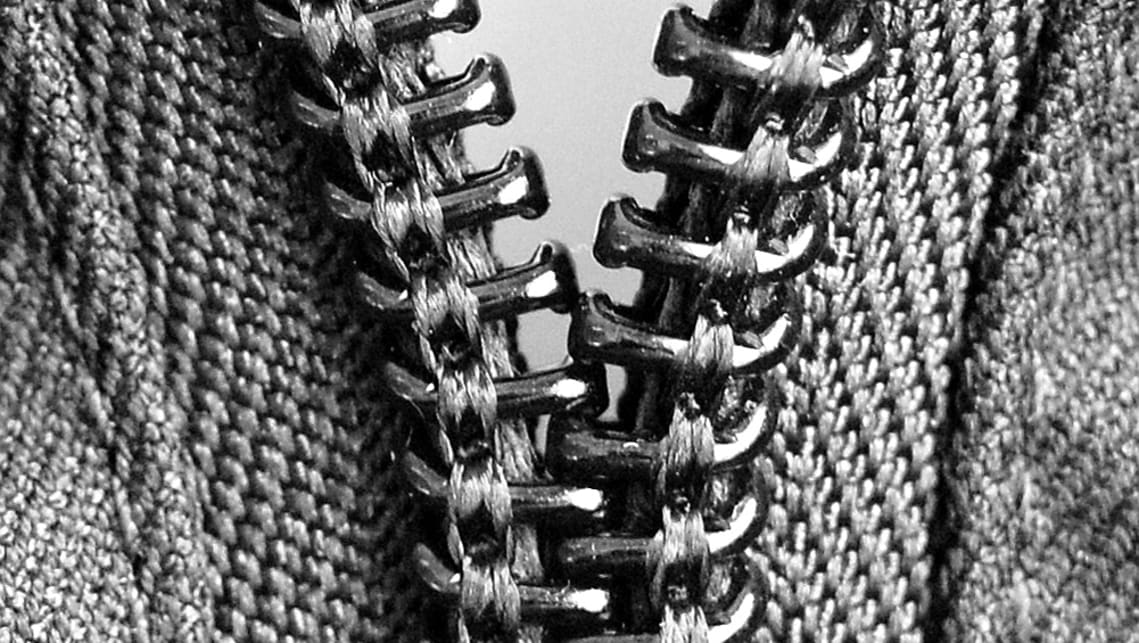
How to merge correctly and why it's important

When you see someone on the road making a total hash, or bash, of merging, and creating huge traffic jams behind them, it's interesting to consider how they ever do their pants up, or leave the house at all.
I always picture them standing, staring down, utterly bemused, at their zipper, slowly tugging it back and forth - if they can work out how to use it at all - with their tongue sticking out as they apply all their brain power to comprehending how it works.
Most people who've seen a zipper in operation, or heard the phrase "merge using the zipper technique", find merging quite simple. Or do they?
It's important to point out, of course, that you can be bad at merging, and you can be bad at letting others merge, and only really inept people are bad at both.
Research conducted in 2016 by Insurance Australia Group (IAG) found more than half (54 per cent) of Australian drivers admitted to having trouble merging with traffic.
They also discovered that 83 per cent of us claim to have experienced other drivers' poor merging technique, which means 17 per cent of Australians never drive in our cities.
What's really surprising, though, is that some of us seem to have a lot more trouble with merging than others. I like to call them West Australians, you might prefer Sand Gropers.
Keep a safe distance between your vehicle and the car in front of you.
Step forward, WA Transport Minister Bill Marmion, who realised that merging was such a problem for Perth drivers that his government needed to spend $200,000 on an unintentionally hilarious How to Merge YouTube video, which literally points out that merging is so simple children can do it.
And also spent vastly more on showing his State's drivers how to do it by painting special lines on 56 'reconfigured' merging lanes on Perth's freeways, to accompany the video.
"When I became Minister for Transport, the very first question I got from the media was 'what do you think about West Australian people merging?'" he told the ABC.
"But the message really is to be courteous. It's really a no brainer."
Mr Marmion declined to comment on whether WA has the worst drivers in the country.
"You do talk to Victorians and other eastern states people and they say they do have their problems as well," he said.
"But we do have a reputation that we've probably created ourselves."
It's important to point out, of course, that you can be bad at merging, and you can be bad at letting others merge, and only really inept people are bad at both.
If you're entering a freeway, or busy road, and you struggle to take the first chance that comes along and then sit there panicking, your eyes blinking along with your indicator, horns going off behind you, then you've got a problem. (Also, you are the reason we have to have those stupid traffic lights on freeway-entry ramps. Civilised countries don't need them, because they can merge.)
But your problem is made worse by the kind of people who just won't let other people merge onto what they apparently consider 'their' road.
Some people are surprised that Australians are so bad at letting others in, but just ask those poor persecuted people marooned on Manus Island about that.
Unsurprisingly, there is plenty of information on WA websites about how to merge properly, and here we present you some of their very simple rules.
THE RULES (not laws, just common-sense ones, really)
Where two lanes merge into one, the vehicle in front has the right of way.
If there are dual lanes, and the lane you are in ends, give way to the vehicles in the lane you are moving into.
Always use your indicator to signal your intentions to other drivers when merging.
Be sure to match the legal speed of the road you're merging into.
Keep a safe distance between your vehicle and the car in front of you and take turns to merge if there are long lines of merging traffic. Yes, turns, where everyone lets one car in… like a zipper.
Be sure to match the legal speed of the road you're merging into. Because strolling out onto a 100km/h motorway doing 40km/h is just stupid.
Robert McDonald, from the IAG Research Centre, says the biggest mistake drivers make is being too slow when attempting to merge. He adds the following advice:
"Avoid stopping in the merging lane, particularly when entering freeways. If you stop, you'll lose speed and it'll be difficult to find a gap large enough for your car to get momentum."
"When turning left into a multi-lane road that has a merging lane, use it. Don't wait to cross over to the lane you want to be in."
"Never merge into another lane by crossing a solid line or a painted traffic island."
"Merge like a zip – one car from each lane at a time." (Just wanted to say that again.)
And finally, a bugbear we often forget:
"When leaving a freeway or road with an off ramp or separate turning lane, don't slow down until you've entered that lane. They are designed to enter at the speed limit."
The man speaks a lot of sense, and much of it seems very simple. And just think, every single person who actually thinks about how to merge on the road, and adapts their behaviour rather than continuing to be rubbish at it, makes life a little bit better.
According to IAG, the worst spots in Australia for merging related accidents include:
• Commonwealth Avenue in Canberra
• Main Road, Sunnybank near Brisbane
• South Road, Edwardstown in Adelaide
• Bell Street, Preston in Melbourne
• Albany Highway in Cannington in Perth
• Sydney's M4 motorway at Flemington, Parramatta, Wentworthville and Silverwater










Comments